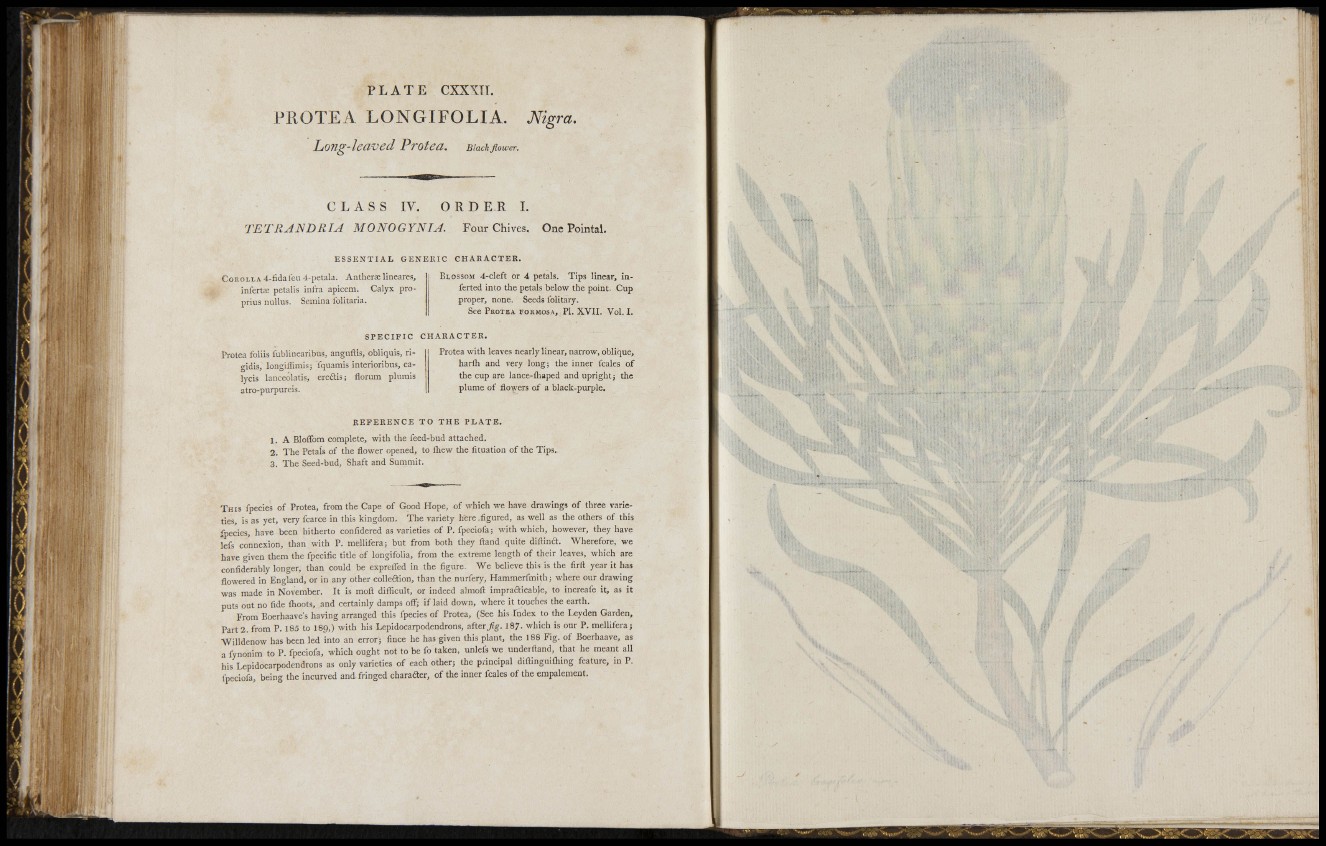
mm
•t
I
P L A T E CXXXTT.
PROTEA LONGIFOLIA. Mgra.
Long-leaved Protea. Blaclt flower.
C L A S S IV. ORDER L
TETRANDRIA MONOGYNIA. Four Chives. One Pointal.
ESSENTIAL GENERIC CHAKACTEK.
COKOLLA 4-iidareu i-petala. Antherae lineares,
inferte petalis intra apicem. Calyx proprius
nullus. Semina iblitaria.
BLOSSOM 4-cleft or 4 petals. Tips linear, inferted
into the petals below the point. Cup
proper, none. Seeds folitary.
See PROTEA EOKMOSA, PI. XVII. Vol. I.
SPECIFIC CHARACTER,
Protea tbliis fublinearibus, angaftis, obliquis, rigidis,
longiflimis; Iquamis interioribns, calycis
lanceolatis, ere£tis; floram plnrais
atro-purpureis.
Protea with leaves nearly linear, narrow, oblique,
harih and very long; the inner fcales of
the cup are lance-fliaped and upright; the
plume of flowers of a black-purple.
REFERENCE TO THE PLATE.
1. A Bloflbm complete, with the feed-bud attached.
2. The Petals of the flower opened, to fliew the fituation of the Tips.
3. The Seed-bud, Shaft and Summit.
T H I S fpecies of Protea, from the Cape of Good Hope, of which we have drawings of three varieties,
is as yet, very fcarce in this kingdom. The variety here figured, as well as the others of this
fpecies, have been hitherto confidered as varieties of P. fpedofa; with which, however, they have
lefs connexion, than with P. mellifera; but from both they ftand quite diftina. Wherefore, we
have given them the fpecific title of longifolia, from the extreme length of their leaves, which are
confiderably longer, than could be exprelTed in the figure. We believe this is the firtt year it has
flowered in England, or in any other colleaion, than the nurfery, Hammerfmith; where our drawing
was made in November. It is moft difficult, or indeed almoft impraaicable, to increafe it, as it
puts out no fide flioot.s, and certainly damps o f f ; if laid down, where it touches the earth.
From Boerhaave's having arranged this fpecies of Protea, (See his Index to the Leyden Garden,
Part 2. from P. 185 to I89,) with his Lepidocarpodendrons, after Jig. 18?. which is onr P. mellifera;
Willdenow has been led into an error; fince he has given this plant, the 188 Fig. of Boerhaave, as
a fynonim to P. fpeciofa, which ought not to be fo taken, unlefs we underttand, that he meant all
his Lepidocarpodendrons as only varieties of each other; the principal diftinguiihing feature, in P.
fpeciofa, being the incurved and fringed charafter, of the inner fcales of the empalement.